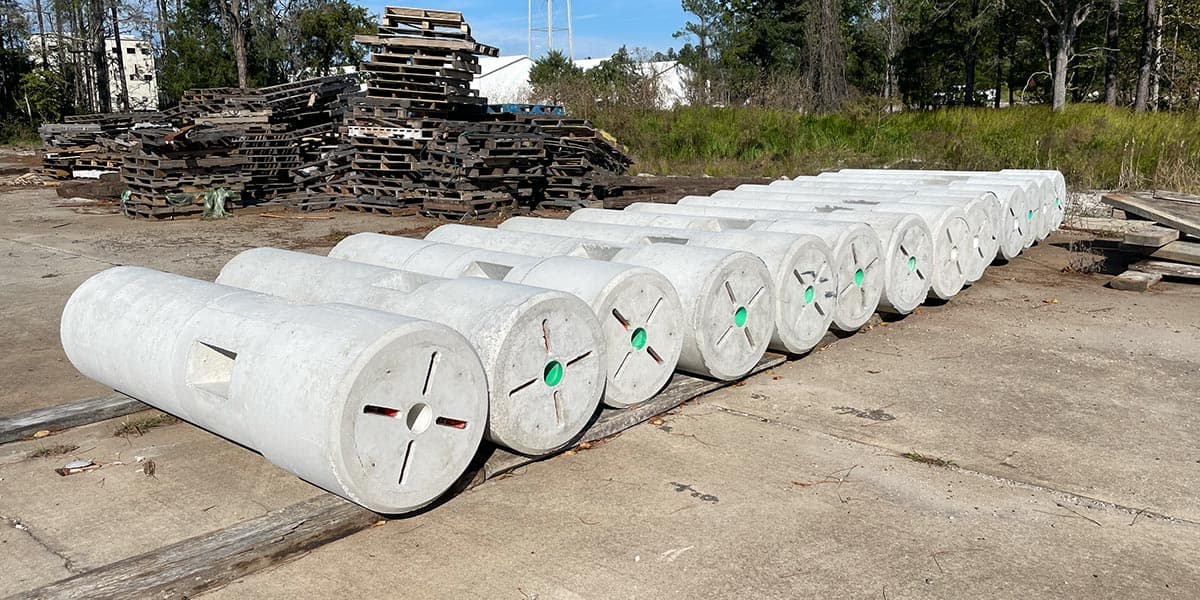Precast vs. Cast-In-Place Light Pole Bases: How to Choose
There are two main types of light pole bases: precast and cast-in-place. There are advantages and disadvantages to each type, and choosing the right one depends on your specific project.
The light pole base is the anchor of the light pole. It is important to choose the right base, as it is critical to the structure’s stability. Choosing the right base also ensures the safety of those around the light pole.
Learn more about the two types of light pole bases and how to choose the best option for your project.
Types of Light Pole Bases
Precast Light Pole Bases
Precast light pole bases are manufactured off-site using forms and molds to ensure that they are built to the required specifications. Once the base is produced, it is transferred to the project site for installation.
Precast concrete’s durability and consistency benefit transportation and parking infrastructure. Review the pros and potential drawbacks of precast bases below.
Pros of Precast Light Pole Bases
- Installation in Inclement Weather: Because precast light pole bases are produced in controlled production environments, they can be installed in practically any weather conditions. This prevents weather delays and allows installation to happen more quickly.
- Same-Day Installation: Since they are pre-constructed by a precast concrete manufacturer and don’t need to be poured on site, precast light pole bases are ready to install immediately. You can place the base, wire, backfill, and mount the pole all in the same day.
- Durability: Precast light pole bases are generally more durable and require less maintenance than their cast-in-place counterparts.
- Minimal Jobsite Impact: Due to the lack of on-site concrete mixing and pouring, precast bases eliminate any mess or disruption at the jobsite.
Potential Drawback of Precast Light Pole Bases
- Design Limitations: Precast bases often have limitations in terms of modifications and customization options because they are made with a predetermined form. There are products including Jensen’s Light Pole Base, that allow for extra flexibility through universal pole bases.
Cast-In-Place Light Pole Bases
Unlike precast light pole bases, cast-in-place light pole bases are poured on-site. While this method has long been the standard option, these bases are not as durable or quick to install as precast bases.
Review the pros and cons of cast-in-place light pole bases below.
Pros of Cast-In-Place Light Pole Bases
- Lower Barrier to Entry: The equipment required for cast-in place (CIP) light pole bases is minimal, which historically made CIP bases advantageous; however, industry changes have led most contractors to avoid CIP work, when possible, due to its extended curing time.
- Customization: CIP bases can be molded and shaped to fit custom project needs, while precast bases historically had design restrictions.
Cons of Cast-In-Place Light Pole Bases
- Higher Labor Cost: Installation is longer and more arduous, leading to higher installation and labor costs.
- Longer Installation Time: These bases take longer to install than precast bases.
- Weather Restrictions: Concrete pouring cannot be done in all weather conditions, which may result in delays.
- Aesthetics: CIP bases are typically less aesthetically pleasing, due to the ring patterns cardboard forms leave during casting.
- Maintenance: CIP bases are generally less durable and require more maintenance than precast bases.
Things to Consider When Choosing a Light Pole Base
Size
Installation
The type of base you choose will also impact the installation timeline, as cast-in-place bases require more time to install than precast bases.
Use Case
Cost
The Importance of Choosing the Right Light Pole Base
Choosing the right light pole base for your project is critical. The base is the foundation of the structure, and the wrong choice could lead to stability issues and safety concerns. A proper light pole base is essential to a functioning system, especially in harsh weather conditions.
It also prevents the light pole from tipping and potentially causing a serious safety hazard. Choosing a quality light pole base ensures the pole is protected from weather damage and corrosion. This maximizes the longevity of the structure and prevents the need for frequent maintenance or repairs, saving the business money over time. Using professional engineering services to handle the design and build can also help guarantee a high-quality product and minimize costs.
Find the Best Fit for Your Project with Jensen
Choosing between precast and cast-in-place bases is heavily dependent on the specifics of your project. Consider all factors carefully before choosing. If you want to compare options for durable light pole bases, consider Jensen Infrastructure. Ready to get started? Contact Jensen Infrastructure today.

